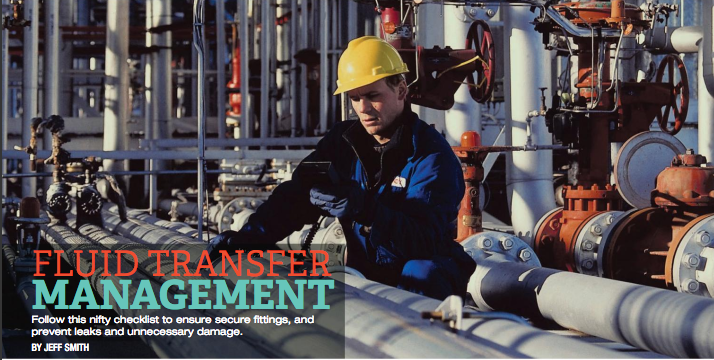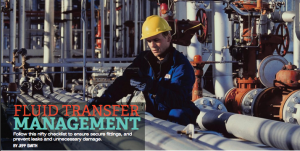
Fluid transfer management – Follow this checklist to ensure secure fittings, and prevent leaks and damage
December 21, 2017 | By Jeff Smith

 Earlier in my career I was a mechanic on the railway. Equipment has always fascinated me. Integrated electronics automating advanced hydraulic systems on track liners, tie inserter cranes – all types of equipment working in harmony! This metal ballet was a thing of beauty. Then, with a rainbow invoking spray of hydraulic oil, the show abruptly ended. I’d watch as the machine helper pulls out a chunk of three-quarter-inch hydraulic hose and quickly spin on a somewhat-clean fitting. I remember a passing thought that if the hose and fittings were cleaner and, if the helper had fit the hose so it would not rub, it might last longer (MTBF). I entered a suggestion that the hoses and fittings should be contained in a sealed box with one end done on each size roll (MTTR). At this point I became obsessed with finding better ways to maintain equipment, I did not realize there was a reliability industry, but who did in 1980?
Earlier in my career I was a mechanic on the railway. Equipment has always fascinated me. Integrated electronics automating advanced hydraulic systems on track liners, tie inserter cranes – all types of equipment working in harmony! This metal ballet was a thing of beauty. Then, with a rainbow invoking spray of hydraulic oil, the show abruptly ended. I’d watch as the machine helper pulls out a chunk of three-quarter-inch hydraulic hose and quickly spin on a somewhat-clean fitting. I remember a passing thought that if the hose and fittings were cleaner and, if the helper had fit the hose so it would not rub, it might last longer (MTBF). I entered a suggestion that the hoses and fittings should be contained in a sealed box with one end done on each size roll (MTTR). At this point I became obsessed with finding better ways to maintain equipment, I did not realize there was a reliability industry, but who did in 1980?
Hydraulic hoses are the nemesis of any heavy-duty mechanic. New equipment for the most part hardly leaks a drop but aged equipment can look like an automated sprinkler system. So what happens during the asset’s lifecycle to enable this transition and can we avoid it? What are the best practices that avoid the “Failed to Contain” failure mode?
First let’s consider a new asset. It arrives on site with all hoses at the exact engineered length. It has been installed without twisting the hose and any angled fittings are positioned the correct way. All the clamping hardware are new and securely fastened. The senior operator claims the unit and enters the cab with pride. The mechanics line up to admire the clean iron and glare at the previous unit as it heads to the scrapyard.
The new unit runs perfectly, but there is one minute issue, a small piece of slag was left on a weld… The slag travels through the hoses and finds a home nestled in the spool of a relief valve. There it contently sits until that system is over pressured and as the relief valve opens to do its job managing the pressure spike, the slags evil nature is revealed as it quickly jams the spool open and the system starts to overheat. As the system gets hotter alarms start sounding, the mechanics leap into action and clean the cooler, when this doesn’t help someone suggest a bigger cooler. Production demands the unit keep working. The alarm is bypassed and the unit runs until the weekend. The tradesmen who have not been trained on the unit start struggling through the schematics, and the vendor is called in. The young CBM guy using thermographic imaging sees the relief valve as the heat source but gives up trying to communicate this as no one has time for him. The expert arrives on site and changes the relief valve, voids the warranty as the unit was run with a heat issue, and everyone is happy as the problem is solved and the unit is back to work.
So what would the residual damage be? Heat hardens seals and embrittles hoses. On the piping the heat deteriorates the neoprene retainers, allowing the piping to shift with vibration, thereby inducing wear. As clearances are minimized with heat, valves can be scored and other problems are seeded. Now we have positioned the unit to require interventions.
Organizations that invest in quality training and allow sufficient time for interventions will not compound the issues. So let’s follow the other trail that leads to the death of a thousand leaks.
It is noted on a PM that a seal has started to leak, so the flange is opened and a new O-ring is installed, but the 45-degree hose end is reinstalled at a slight improper angle. The hose no longer bends with the motion but has a slight twisting motion. Eventually the motion weakens the wire and the hose fails. The warehouse is contacted and they are given measurements to make up a new hose, not realizing the mechanic had given them fitting-to-fitting lengths, which they interpreted as hose length. The longer hose is installed and starts rubbing on a component but hey the equipment is back up and running. Meanwhile the piping with the melted neoprene retainer starts to shift and wears a hole in the pipe, the pipe is replaced with a hose… and so starts the death spiral.
Piping and hoses, like fasteners, are not often given the quality of workmanship they require. They are also not given the consideration as supply chain items they deserve. Hydraulic system leakage should not be normalized and isn’t hard if a few things are done right. Here are some key things to consider.
Hoses, Seals, Piping
- Conduct inspections that are targeted and quantifiable. General PM statements like hoses OK do not deliver the quality control required. Example: Inspect boom to stick hose arch set for leakage (Target the inspection), loose / worn clamps and retainers, Include instructions to resolve finding (Loose bolts are torqued to x), Ensure angled hose ends are positioned as shown (Include pictures).
- Ensure that hose and piping installation practices are understood and adhered to. Train your people and inspect workmanship. Do not accept substandard work. If a quick field repair is conducted make sure it is followed up during the next PM to validate quality.
- Stock the working hoses. If you chose to make you own hoses have the vendor provide the dimensions and try to avoid general field measurements. Also understand the pressure requirements and other considerations. If hose armor is required have it available.
- Stock the retaining hardware. Clamps and hose retainers get lost, worn, melt etc. If they are not available they are often replaced with substandard items like tie wraps.
- Utilize a criticality ranking for hose systems. Some failures may be life threatening, some may be minor. Establish business logic, for example critical hoses will be stocked and have detailed inspections; non-critical ones will be made up as required.
- Do not replace piping with hoses. Piping has less internal resistance and cools oil, hoses heat oil. If you have to bypass a pipe with a hose ensure it is followed up and corrected.
- Utilize consumption tracking for top up. It is imperative to understand the volume added as some leakage is not evident to the operator. If a machine is flagged to excessive consumption resolve the issue.
- When disassembling a unit post catastrophic failure, document the hose layout. Ensure you label each hose and provide pictures of the installation. The time spent documenting the disassembly will be recovered in both speed and quality on the reassembly.
- Avoid general O-ring kits. O-rings are not a simple as they seem. There are sizing issues and durometer ratings (hardness), backing variation, and so forth. It is better to have the vendor provide a kit for the machine and keep it on the machine. Regardless of the maintainer, they have the correct seal readily available.
- Install the fittings correctly. Always use two wrenches to avoid twisting the hose and do not over tighten. The label (writing) on a hose is called the “Lay Line.” Look it over to inspect for twisting, and reinstall if required. Validate that the fitting are correct and ensure the treads are clean an undamaged.
- Do not install hoses with compound bends. They should be limited to one plane of motion.
Safety considerations
Ensure all working attachments are on the ground or locked prior to working on any hydraulic system. Release any stored energy in the system. Some systems have accumulators that require bleeding prior to disassembly. And do not feel for leaks on energized systems; if there is a pinhole leak the pressure can easily cut off parts you will miss having.
Work with precision
There is no reason assets should become leakers, if the listed items are followed. In my experience it is mostly rushed jobs conducted with wrong parts that lead to bleeding machines. When I see an industrial organization with leaking equipment it is easy to assume they have a reactive culture. Quality workmanship and having the correct stock requires executive sponsorship and a culture that believes things can and should be done correctly. Precision maintenance is the primary element that enables reliability and cost control. Apply it to your hoses and fittings.
This article appears in the June 2017 issue of Machinery and Equipment MRO.
Jeff Smith is the owner of 4TG Industrial and a reliability subject matter expert. to our sister publication Machinery and Equipment MRO. His work spans a cross section of industries, including oil sands, mining, pulp and paper, packaging, petrochemical, marine, brewing, transportation and synfuels. Reach him at jsmith@acuren.com.
